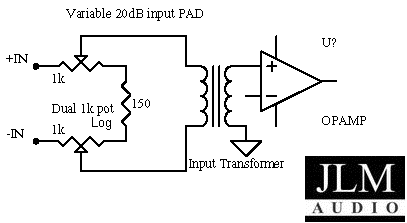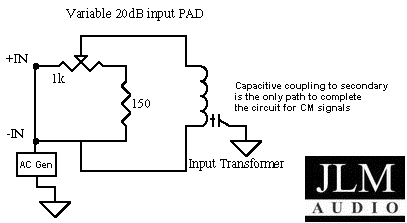Okay. Trying to get my head around what you are saying here. This should reveal some of what I do and do not know. I know this is fine in practice (and in my head) with floating transformer coupled line level sources having T pads between them, I'm just not quite seeing this clear for mics and mic levels.
I'm curious why so many app notes go on about the importance of 1% matched resistors for balanced mic pads. Certainly they are not thinking about center tapped transformers, since they went out of fashion long before the common use of U pads for mics.
Disregarding the impedance matching situation (vs. bridging) then, are we to assume there's no balancing issue with the billions of antique remote mixers which use T pads on mic inputs in front of a floating transformer? No increase in issues related to differing series resistance in a low-level line?
Also, disregarding balance, if we put a true 150 ohm mic on this pad, with it set at the halfway point, we get (2 x) 1150 ohms in parallel at the wipers, or 575 ohms loading the transformer primary (415 ohms reflected to the mic, assuming a true 1500 ohms from the transformer(?)) that wants to see 150-200 ohms for proper Fi. (I realize it's more complicated than that; please explain how, if possible, for the benefit of all. Or point out where it's already discussed.) We only get near 150 ohms to the transformer at close to full on, or full off, and 140 ohms at full on and off. This will probably be fine with some modern transformers, but will probably have noticable sonic affectations with many retro-fitted vintage types. This must assume a secondary load rather than a classic unloaded situation. Again, please point out where I'm wrong, so I can correct my understanding.
This is an over-simplified version of the issues too, since a 150 ohm mic on a transformer will have a different loading effect than a 150 ohm resistor on the transformers performance. The whole point of the U pad made with fixed resistors seems to be maintenance of the 150 load on the transformer primary, and the 1200-1500ish bridging load on the mic.
Someone please point out where this has been discussed before; I've not spotted it yet.
Seeing triple, time for sleep.......maybe I'll wake up and understand the error in my thinking. And nuke this post....
Thanks,








